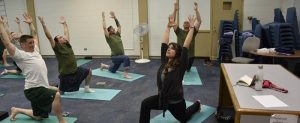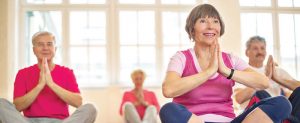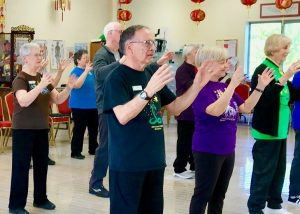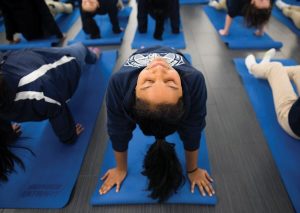Improve the Psychological Health in Breast Cancer Patients with Mindfulness
By John M. de Castro, Ph.D.
“Mindfulness is a state of mind which we can all acquire and use to support our wellbeing physically, emotionally and mentally. . . Having cancer, or specifically breast cancer, is no exception. Our cancer experiences take up a lot of energies, mental focus and can drain us emotionally. It is important to have a few tools to help us create ‘down’ and ‘out’ times, and to replenish and reconnect with who we are. “ – Breast Cancer Now
Receiving a diagnosis of cancer has a huge impact on most people. Feelings of depression, anxiety, and fear are very common and are normal responses to this life-changing and potentially life-ending experience. But cancer diagnosis is not necessarily a death sentence. Over half of the people diagnosed with cancer are still alive 10 years later and this number is rapidly increasing. But, surviving cancer carries with it a number of problems. Anxiety, depression, fatigue and insomnia are common symptoms in the aftermath of surviving breast cancer. These symptoms markedly reduce the quality of life of the patients.
Mindfulness training has been shown to help with cancer recovery and help to relieve chronic pain. It can also help treat the residual physical and psychological symptoms, including stress, sleep disturbance, fear, and anxiety and depression. There has been considerable research conducted on the effectiveness of mindfulness practices in treating the psychological issues associated with cancer. So, it makes sense to step back and summarize what has been learned.
In today’s Research News article “Mindfulness-based stress reduction for women diagnosed with breast cancer.” (See summary below or view the full text of the study at: https://www.ncbi.nlm.nih.gov/pmc/articles/PMC6436161/), Schell and colleagues review, summarize, and perform a meta-analysis of the published research studies investigating the effectiveness of the Mindfulness-Based Stress Reduction (MBSR) program for the treatment of the psychological problems that occur in women who survive breast cancer. MBSR includes meditation, body scan, yoga practices, and discussion along with daily home practice. They identified 14 randomized controlled trials.
They report that the published research studies provide evidence that the Mindfulness-Based Stress Reduction (MBSR) program improves the quality of life and sleep and reduces anxiety, depression, and fatigue in breast cancer patients. The effect sizes are small and the effects were no longer present at long-term follow-up a year after the end of treatment. MBSR is a complex of practices and the research to date cannot differentiate which components or which combination of components are responsible for the benefits.
There is substantial evidence that mindfulness training improves quality of life and sleep and reduces anxiety, depression, and fatigue in a wide variety of healthy and ill individuals. The present results suggest that it also has these benefits for women suffering with breast cancer. Hence, MBSR may be recommended to improve the psychological health of breast cancer patients.
So, improve the psychological health in breast cancer patients with mindfulness.
“Studies have shown mindfulness-based stress reduction can be effective in alleviating anxiety and depression, decreasing long-term emotional and physical side effects of treatments and improving the quality of sleep in breast cancer patients.” – Breast Cancer Research Foundation
CMCS – Center for Mindfulness and Contemplative Studies
This and other Contemplative Studies posts are also available on Google+ https://plus.google.com/106784388191201299496/posts and on Twitter @MindfulResearch
Study Summary
Schell, L. K., Monsef, I., Wöckel, A., & Skoetz, N. (2019). Mindfulness-based stress reduction for women diagnosed with breast cancer. The Cochrane database of systematic reviews, 3(3), CD011518. https://doi.org/10.1002/14651858.CD011518.pub2
Abstract
Background
Breast cancer is the most common cancer in women. Diagnosis and treatment may drastically affect quality of life, causing symptoms such as sleep disorders, depression and anxiety. Mindfulness‐based stress reduction (MBSR) is a programme that aims to reduce stress by developing mindfulness, meaning a non‐judgmental, accepting moment‐by‐moment awareness. MBSR seems to benefit patients with mood disorders and chronic pain, and it may also benefit women with breast cancer.
Objectives
To assess the effects of mindfulness‐based stress reduction (MBSR) in women diagnosed with breast cancer.
Search methods
In April 2018, we conducted a comprehensive electronic search for studies of MBSR in women with breast cancer, in the Cochrane Central Register of Controlled Trials (CENTRAL), MEDLINE, Embase, and two trial registries (World Health Organization’s International Clinical Trials Registry Platform (WHO ICTRP) and ClinicalTrials.gov). We also handsearched relevant conference proceedings.
Selection criteria
Randomised clinical trials (RCTs) comparing MBSR versus no intervention in women with breast cancer.
Data collection and analysis
We used standard methodological procedures expected by Cochrane. Using a standardised data form, the review authors extracted data in duplicate on methodological quality, participants, interventions and outcomes of interest (quality of life, fatigue, depression, anxiety, quality of sleep, overall survival and adverse events). For outcomes assessed with the same instrument, we used the mean difference (MD) as a summary statistic for meta‐analysis; for those assessed with different instruments, we used the standardised mean difference (SMD). The effect of MBSR was assessed in the short term (end of intervention), medium term (up to 6 months after intervention) and long term (up to 24 months after intervention).
Main results
Fourteen RCTs fulfilled our inclusion criteria, with most studies reporting that they included women with early breast cancer. Ten RCTs involving 1571 participants were eligible for meta‐analysis, while four studies involving 185 participants did not report usable results. Queries to the authors of these four studies were unsuccessful. All studies were at high risk of performance and detection bias since participants could not be blinded, and only 3 of 14 studies were at low risk of selection bias. Eight of 10 studies included in the meta‐analysis recruited participants with early breast cancer (the remaining 2 trials did not restrict inclusion to a certain cancer type). Most trials considered only women who had completed cancer treatment.
MBSR may improve quality of life slightly at the end of the intervention (based on low‐certainty evidence from three studies with a total of 339 participants) but may result in little to no difference up to 6 months (based on low‐certainty evidence from three studies involving 428 participants). Long‐term data on quality of life (up to two years after completing MBSR) were available for one study in 97 participants (MD 0.00 on questionnaire FACT‐B, 95% CI −5.82 to 5.82; low‐certainty evidence).
In the short term, MBSR probably reduces fatigue (SMD −0.50, 95% CI −0.86 to −0.14; moderate‐certainty evidence; 5 studies; 693 participants). It also probably slightly reduces anxiety (SMD −0.29, 95% CI −0.50 to −0.08; moderate‐certainty evidence; 6 studies; 749 participants), and it reduces depression (SMD −0.54, 95% CI −0.86 to −0.22; high‐certainty evidence; 6 studies; 745 participants). It probably slightly improves quality of sleep (SMD −0.38, 95% CI −0.79 to 0.04; moderate‐certainty evidence; 4 studies; 475 participants). However, these confidence intervals (except for short‐term depression) are compatible with both an improvement and little to no difference.
In the medium term, MBSR probably results in little to no difference in medium‐term fatigue (SMD −0.31, 95% CI −0.84 to 0.23; moderate‐certainty evidence; 4 studies; 607 participants). The intervention probably slightly reduces anxiety (SMD −0.28, 95% CI −0.49 to −0.07; moderate‐certainty evidence; 7 studies; 1094 participants), depression (SMD −0.32, 95% CI −0.58 to −0.06; moderate‐certainty evidence; 7 studies; 1097 participants) and slightly improves quality of sleep (SMD −0.27, 95% CI −0.63 to 0.08; moderate‐certainty evidence; 4 studies; 654 participants). However, these confidence intervals are compatible with both an improvement and little to no difference.
In the long term, moderate‐certainty evidence shows that MBSR probably results in little to no difference in anxiety (SMD −0.09, 95% CI −0.35 to 0.16; 2 studies; 360 participants) or depression (SMD −0.17, 95% CI −0.40 to 0.05; 2 studies; 352 participants). No long‐term data were available for fatigue or quality of sleep.
No study reported data on survival or adverse events.
Authors’ conclusions
MBSR may improve quality of life slightly at the end of the intervention but may result in little to no difference later on. MBSR probably slightly reduces anxiety, depression and slightly improves quality of sleep at both the end of the intervention and up to six months later. A beneficial effect on fatigue was apparent at the end of the intervention but not up to six months later. Up to two years after the intervention, MBSR probably results in little to no difference in anxiety and depression; there were no data available for fatigue or quality of sleep.
https://www.ncbi.nlm.nih.gov/pmc/articles/PMC6436161/









 Long-Term Meditators have More Frequent Lucid Dreams
Long-Term Meditators have More Frequent Lucid Dreams